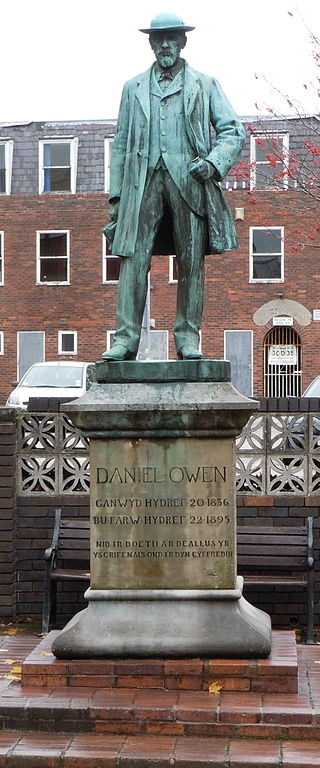Related Research Articles

Daniel Owen was a Welsh novelist. He is generally regarded as the foremost Welsh-language novelist of the 19th century and the first significant novelist to write in Welsh.

Dolwyddelan is a village and community in Conwy county borough, Wales, on the main A470 road between Blaenau Ffestiniog and Betws-y-Coed. As a community, the population of Dolwyddelan was recorded in the 2001 Census as 427, and 55.8% of those residents could speak Welsh. The population increased to 474 in the 2011 census with the proportion of Welsh speakers falling to 50.8%.

Brenda Irene Chamberlain was a Welsh artist, poet and writer. She won the first two Gold Medals awarded by the National Eisteddfod of Wales in the Fine Art category, for her paintings Girl with a Siamese Cat (1951) and The Cristin Children (1953), and her written works include Tide-race, a memoir of 15 years spent living on Bardsey Island. An expatriate on the island of Hydra, Greece, from 1961 to 1967, she then returned to Wales, where she died in 1971. Her papers are preserved by the National Library of Wales; examples of her artworks are found in several collections.
This article is about the particular significance of the year 1998 to Wales and its people.
This article is about the particular significance of the year 1996 to Wales and its people.
This article is about the particular significance of the year 1965 to Wales and its people.
Menna Elfyn FLSW is a Welsh poet, playwright, columnist, and editor who writes in Welsh. She has been widely commended and translated. She was imprisoned for her campaigning as a Welsh-language activist.
The Tir na n-Og Awards are a set of annual children's literary awards in Wales from 1976. They are presented by the Books Council of Wales to the best books published during the preceding calendar year in each of three awards categories, one English-language and two Welsh-language. Their purpose is "[to raise] the standard of children's and young people's books and to encourage the buying and reading of good books." There is no restriction to fiction or prose. Each prize is £1,000.
This article is about the particular significance of the year 1891 to Wales and its people.
This article is about the particular significance of the year 1886 to Wales and its people.

Twm Morys is a Welsh poet and musician.
John Rowlands was a Welsh language author of several novels including Lle bo'r gwenyn. He was also a professor of Welsh literature.
This article is about the particular significance of the year 2010 to Wales and its people.
David Heslin Rowlands was a Congregational minister, lecturer and writer. Rowlands won the crown at the National Eisteddfod in 1969 and 1972, and was made archdruid in 1996.

The Gold Medal of the National Eisteddfod of Wales is awarded annually in three categories for excellence in Fine Art, Architecture, or Craft and Design.

Thomas Hughes Jones was a Welsh poet and writer from Ceredigion (Cardiganshire) in West Wales. He wrote several collections of stories and contributed to various journals, including Welsh Outlook, throughout his career. In 1940 he won the Literature Medal for his story, "Sgweier Hafila", at the National Eisteddfod. His pen name was generally abbreviated to "T. Hughes Jones".

Manon Steffan Ros is a Welsh novelist, playwright, games author, scriptwriter and musician. She is the author of over twenty children's books and three novels for adults, all in Welsh. Her award-winning novel Blasu has been translated into English, under the title of The Seasoning. In May 2021 she was described as "arguably the most successful novelist writing in Welsh at the moment".
Lleucu Roberts is a Welsh author.
Caryl Lewis is a Welsh novelist. She won the Wales Book of the Year in 2005 with her novel Martha Jac a Sianco, which was adapted into a film in 2008.
Rhiannon Davies Jones was a Welsh historical novelist, lecturer and Welsh nationalist who wrote in Welsh. Educated at University College Bangor, she won two prizes for short novels, two Prose Medals at the National Eisteddfod of Wales and the crown at the 1973 Anglesey Eisteddfod. Jones published ten novels with her works covering fictional diaries, her political beliefs and responses to political events, and Welsh kings and princes.
References
- 1 2 3 4 Bissett, Daniel (18 June 2016). "Waunfawr farm sparks childhood memories for author in 3 Lle". North Wales Daily Post . Retrieved 20 October 2016.
- 1 2 3 4 5 6 3 Lle: Eigra Lewis Roberts [3 Places: Eigra Lewis Roberts] (in Welsh). S4C. 19 June 2016. Retrieved 12 August 2017.
- ↑ Stephens, Meic (17 May 2015). "John Rowlands: Author who eschewed popular taste in order to explore the human mind and his own inner life". The Independent . Retrieved 22 October 2016.
- 1 2 3 4 "Eigra Lewis Roberts". BBC Cymru (in Welsh). Retrieved 22 October 2016.
- 1 2 "Return ticket, by Eigra Lewis Roberts". Wales Online . 25 March 2006. Retrieved 22 October 2016.
- ↑ Sturrock, John (1997). The Oxford Guide to Contemporary World Literature. Oxford University Press. p. 434. ISBN 9780192833181 . Retrieved 22 October 2016.
- ↑ Jones, John Graham (2014). The History of Wales. University of Wales Press. ISBN 9781783161706 . Retrieved 22 October 2016.
- ↑ The Celts: History, Life, and Culture. ABC-CLIO. 2012. p. 796. ISBN 9781598849646 . Retrieved 22 October 2016.
- ↑ "2013 Wales Book of the Year Award Shortlist". Literary Festivals. 14 May 2015. Retrieved 22 October 2016.
- ↑ British National Bibliography. Retrieved 5 June 2020.